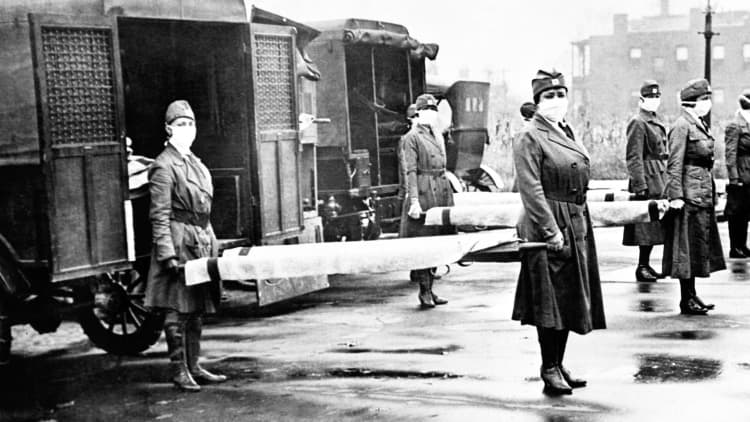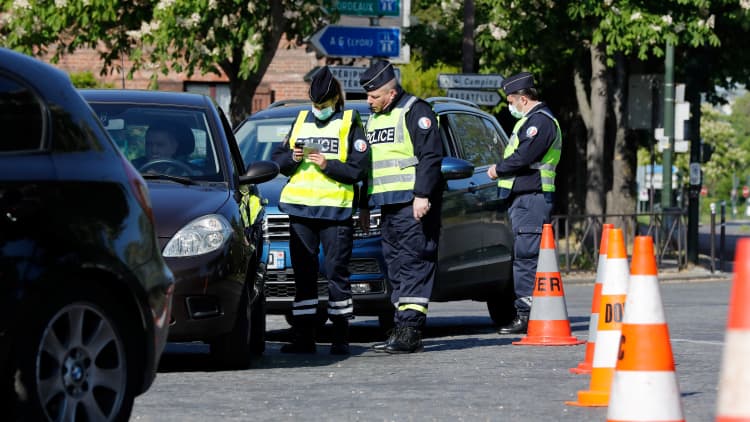LONDON — There can be no doubt now that Europe is now facing the much-feared "second wave" of coronavirus cases, after severe restrictions on public life were lifted and the summer lull in new infections came to an end.
As cases rise rapidly in the region, various European nations are taking action in an effort to stop the surge in infections and prevent a significant rise in fatalities.
To date, there have over 2.9 million confirmed cases of the virus in Europe and over 186,000 people have died, data from the European Centre for Disease Control and Prevention shows. In descending order, Spain, France, the U.K., Italy and Germany have seen the highest numbers of infections during the pandemic, so far.
Despite the risks accompanying a surge in infections, leaders in the region are reluctant to impose nationwide lockdowns again, given the economic and societal implications of such moves, and are now looking at more targeted, localized measures.
Here's a snapshot of what Europe's biggest economies are doing to stop the spread of the virus:
Spain
Spain has recorded 682,267 infections — the highest number in Europe, and 30,904 deaths, according to the latest Johns Hopkins University data. On Tuesday, more than 10,000 new infections were recorded, up from the previous day's tally, according to Spanish health ministry data.
Madrid has become a virus hotspot, with 953 new cases reported Tuesday. The surge has prompted the president of the city's regional government to request help from the army to help battle the rise and parts of the capital have been put in lockdown, prompting protests.
Spanish Prime Minister Pedro Sanchez warned Monday that data in Madrid showed "the infection rate is double the national level, the numbers of intensive care beds in use is three times the national level." He signaled more stringent measures could be introduced in the city, saying it "demands its own plan," El Pais reported.
France
France has the second-highest number of confirmed coronavirus cases in Europe after Spain, with 507,150 infections to date and 31,426 deaths, JHU data notes.
France reported just over 10,000 new infections Tuesday from the previous day. Last Friday, France reported 13,215 new infections, its highest daily number since the start of the pandemic.
As a result of surging cases, the city of Lyon (France's third-largest city) has introduced tighter restrictions, limiting public gatherings and prohibiting the sale and consumption of alcohol outdoors after 8pm, France 24 reported Monday. Visits to nursing home residents will also be restricted to two per week. Similar restrictions have already been imposed in other cities including Marseille and Bordeaux.

UK
The U.K. has also seen a dramatic rise in coronavirus cases over recent days, prompting the government to introduce localized lockdown measures in parts of northern England and more national restrictions. To date, the country has recorded just over 406,058 coronavirus cases and 41,951 deaths, according to the JHU. Almost 5,000 new infections were reported Tuesday, government data showed.
On Tuesday, Prime Minister Boris Johnson said Britain was at a "perilous turning point" as he called on people to work from home once again if possible and that pubs and restaurants would have to close from 10 p.m. Groups of more than six people are already not allowed to meet. Johnson warned that the measures could be in place for up to six months.
It was reported that the prime minister had been considering a "mini" national lockdown of two weeks to try to act as a "circuit-breaker" in an effort to stop the spread of the virus, but he stopped short of that Tuesday and there is a reluctance to damage the economy further.
The government's chief medical and scientific advisors warned on Monday that, without action, the U.K. could see up to 50,000 new coronavirus cases per day by mid-October, which could lead to 200-plus deaths per day by November.
Germany
Germany was praised for its initial response to the first wave of the coronavirus crisis. To date, Germany has recorded over 277,412 cases, but has reported fewer than 10,000 deaths, JHU data shows, a far lower number of fatalities than its European counterparts.
Nonetheless, data from the Robert Koch Institute (RKI) shows that cases are rising, particularly in the cities of Munich and Hamburg. On Wednesday, a further 1,769 cases were reported after 1,821 new infections were registered Tuesday, the RKI noted. German Chancellor Angela Merkel has reportedly called for a crisis summit next week with regional governors, German media reported Monday.
Munich has tightened rules on face masks, which must now be worn in public, and contact restrictions. German Health Minister Jens Spahn has also said Germany will step up its testing regime as cases rise.
On Monday, the RKI called for "the entire population to be committed to infection control" by consistently observing rules of distance and hygiene, and advising that "crowds of people should be avoided if possible and celebrations should be limited to the closest circle of family and friends."

Italy
Italy was the epicenter of Europe's first outbreak in late winter, with the first outbreak in Europe appearing in the north of the country in February. To date, Italy has reported just over 300,000 cases and 35,738 fatalities.
Italy is also seeing a rise in new infections, but, like Germany, not at the rate of its neighbors. On Tuesday, 1,392 new cases were reported, the health ministry said, up from 1,350 new infections Monday.
Italian politicians are reluctant to return to a severe lockdown that saw Italians banned from leaving their homes for all but the most essential reasons.
Instead, Italy appears to be looking to test people arriving from other European virus hotspots. Health Minister Roberto Speranza said in a Facebook post Monday that he had signed an order making it obligatory for people arriving in Italy "from Paris or other parts of France with significant circulation" of the coronavirus to be tested.
Speranza added that European data on Covid-19 "must not be underestimated," and that while "Italy is better off than other countries ... great prudence is still needed to avoid rendering the sacrifices made up to now in vain."



